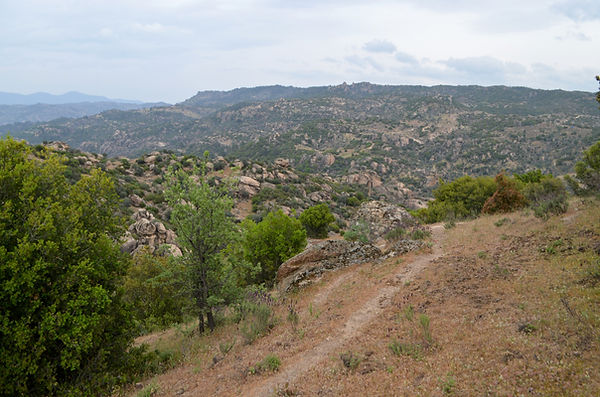Around 50 km east of the Latmos area in Eastern Caria, there are Byzantine frescoes on an exposed rocky bluff at a site known in Turkish as Papaz Kayası (“Priest’s Rock”). It is on the western side of the valley of the Marsyas Stream (Turkish Çine Çayı) near the village of Yava in Yatağan, Muğla. It was around 4.5 south of the Roman bridge İncekemer, which is now submerged under the waters of the Adnan Menderes Dam.
The frescoes are on the northern face of a tall rocky bluff overlooking a small canyon running west of the Marsyas Valley. There is a flat terrace-like area under this high rock and its frescoes, which is around 25 meters in length. Remains of an eastern-oriented chapel, which used the wall of the high rock as its southern wall, can also be found on this terrace.
There are two distinct fresco layers on a lower level of the high rock. The first layer of frescoes, which is in much worse condition, was made using the “secco” technique, painted directly on the rock without the use of plaster. In addition, there is also another area with “secco” crosses. This first layer is much lower to the ground and to the right of the better-preserved second layer. Traces of plaster suggest it was later painted over in a second phase, as seen in Cappadocia. However it is also possible they were sketches that the artists painted over, rather than works of art in their own right. As the first layer is much more weathered, it is much harder to read. It included panels with scenes from the Lives of the Virgin Mary and Christ, but only the Meeting of Elizabeth and Mary and the Crucifixion are identifiable. The Crucifixion scene includes a red sun and a moon flanking the cross. Below these panels are seven unidentifiable saints, bishops, or church fathers in medallions.
The second layer of frescoes, painted on a thin layer of plaster, is better preserved. It is more than 3 meters above the ground level of the terrace-like area with the ruins of a chapel. It consists of four large, relatively well-preserved panels of different sizes, and likely dates to either the 12th or 13th centuries. The largest panel, which is on the left, depicts a standing archangel in an imperial costume holding a lance in his right hand and a globe in his left hand. His head is mostly destroyed, but he has a yellow halo. His loros is richly decorated with precious stones and pearls and his boots are red. The panel with the archangel is followed by three connected panels. The first panel shows the Meeting of Joachim and Anna; the narrative of the parents of the Virgin Mary meeting after learning Anna is with child found in the Protoevangelium of James. While the faces of the two figures are now significantly damaged, their cheeks touch and they embrace each other. Both figures have yellow halos, while Joachim has light brown hair and a thick beard. Joachim’s garments are yellow-white and pinkish, while Anna is dressed in deep red.
The central panel depicts a standing Virgin Mary holding the Christ Child flanked by John the Baptist and John the Evangelist. The Virgin Mary wears a deep purple maphorion and a bluish-white tunic. She points towards Christ with her right hand, while Christ raises his right hand in the gesture of blessing. He has a yellow halo with a cross, which is flanked by the abbreviations IC and XC. The figure on the left, John the Baptist, has long brown hair and is dressed in brownish animal skins. While the scepter he holds is still visible, the scroll in his left hand has largely been erased. The figure on the left, St. John the Evangelist, wears bluish-white and light purple garments. His head is now largely destroyed, but it is possible to make out his partially bald and white hair.
The final panel on the right includes a standing Christ, raising his right hand in the gesture of blessing and holding a codex decorated with precious stones and pearls in his left hand. His head, which is better preserved, is surrounded by a yellow halo with a cross. He has dark brown hair and beard, while his oval-shaped face is tan with greenish tones. His garments are white with touches of pinks and blues, as well as orange and pinkish. A smaller figure to the right slightly turns towards Christ. He holds a model of a church in his right hand and gestures towards Christ with his left hand. Unlike the other figures, he does not have a halo. He is partially bald and has white hair and beard. His garments, which suggest he is a monk or an abbot, are purple and pinkish. It is possible that he is the abbot who donated this monastery.
Details of Christ and possible donating abbot
Archangel holding a globe and lance
The globe has the ΦΧΦΠ tetragram, which can be read as:
Φῶς Χριστοῦ φαίνει πᾶσιν (“The light of Christ shines for all”)
Virgin Mary holding the Christ Child
Meeting of Joachim and Anna
First layer of frescoes
“Secco” crosses
Chapel ruins
General view of the high rock and frescoes
General view of the area
Sources
Zäh, A. and Ruggieri, V. Visiting the Byzantine Wall Paintings in Turkey
Ötüken, Y. “Yatağan İlçesine Bağlı Yava Köyü Yakınlarındaki Bizans Freskoları I. İkonografik İncelemeler”
Reference











